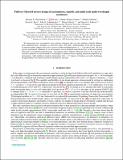| dc.contributor.author | Christiansen, Rasmus E | |
| dc.contributor.author | Lin, Zin | |
| dc.contributor.author | Roques-Carmes, Charles | |
| dc.contributor.author | Salamin, Yannick | |
| dc.contributor.author | Kooi, Steven E | |
| dc.contributor.author | Joannopoulos, John | |
| dc.contributor.author | Soljacic, Marin | |
| dc.contributor.author | Johnson, Steven G | |
| dc.date.accessioned | 2020-10-29T18:32:28Z | |
| dc.date.available | 2020-10-29T18:32:28Z | |
| dc.date.issued | 2020-10 | |
| dc.date.submitted | 2020-09 | |
| dc.identifier.issn | 1094-4087 | |
| dc.identifier.uri | https://hdl.handle.net/1721.1/128249 | |
| dc.description.abstract | We demonstrate new axisymmetric inverse-design techniques that can solve problems radically different from traditional lenses, including reconfigurable lenses (that shift a multi-frequency focal spot in response to refractive-index changes) and widely separated multi-wavelength lenses (λ = 1 µm and 10 µm). We also present experimental validation for an axisymmetric inverse-designed monochrome lens in the near-infrared fabricated via two-photon polymerization. Axisymmetry allows fullwave Maxwell solvers to be scaled up to structures hundreds or even thousands of wavelengths in diameter before requiring domain-decomposition approximations, while multilayer topology optimization with ∼10[superscript 5] degrees of freedom can tackle challenging design problems even when restricted to axisymmetric structures. | en_US |
| dc.description.sponsorship | Army Research Office (Grant W911NF-18-2-0048) | en_US |
| dc.publisher | Optical Society of America (OSA) | en_US |
| dc.relation.isversionof | http://dx.doi.org/10.1364/oe.403192 | en_US |
| dc.rights | Article is made available in accordance with the publisher's policy and may be subject to US copyright law. Please refer to the publisher's site for terms of use. | en_US |
| dc.source | OSA Publishing | en_US |
| dc.title | Fullwave Maxwell inverse design of axisymmetric, tunable, and multi-scale multi-wavelength metalenses | en_US |
| dc.type | Article | en_US |
| dc.identifier.citation | Christiansen, Rasmus E. et al. "Fullwave Maxwell inverse design of axisymmetric, tunable, and multi-scale multi-wavelength metalenses." Optics Express 28, 23 (October 2020): 33854-33868 © 2020 Optical Society of America | en_US |
| dc.contributor.department | Massachusetts Institute of Technology. Department of Mathematics | en_US |
| dc.contributor.department | Massachusetts Institute of Technology. Research Laboratory of Electronics | en_US |
| dc.contributor.department | Massachusetts Institute of Technology. Department of Physics | en_US |
| dc.contributor.department | Massachusetts Institute of Technology. Institute for Soldier Nanotechnologies | en_US |
| dc.relation.journal | Optics Express | en_US |
| dc.eprint.version | Final published version | en_US |
| dc.type.uri | http://purl.org/eprint/type/JournalArticle | en_US |
| eprint.status | http://purl.org/eprint/status/PeerReviewed | en_US |
| dspace.date.submission | 2020-10-27T22:50:12Z | |
| mit.journal.volume | 28 | en_US |
| mit.journal.issue | 23 | en_US |
| mit.license | PUBLISHER_POLICY | |
| mit.metadata.status | Complete | |

